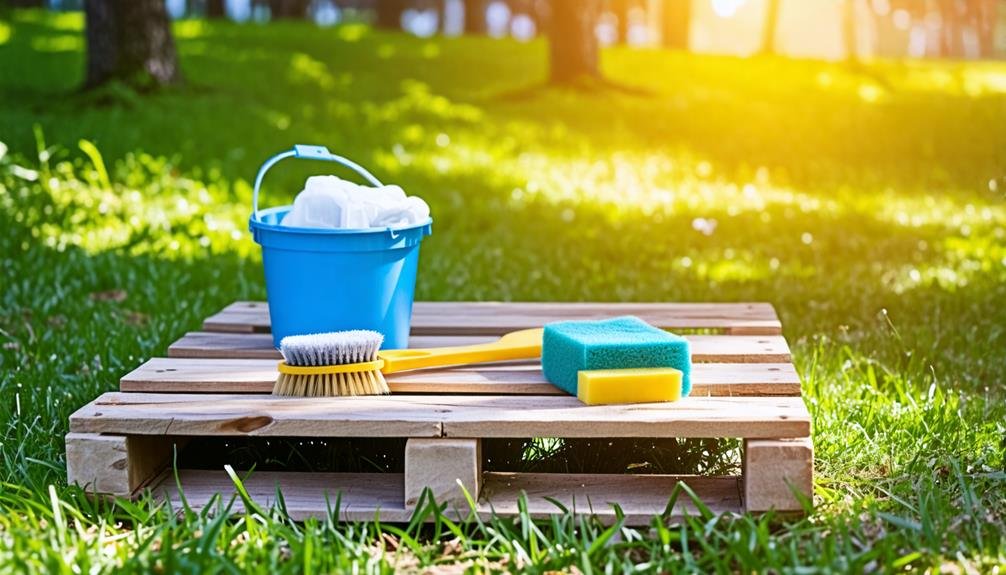To clean wood pallets effectively before your DIY project, start with a thorough inspection to identify damage and pests. Use a pressure washer for deep cleaning, and follow up with a scrub brush for stubborn residues. Disinfect the surface with a bleach solution or a vinegar-water mix, ensuring proper ventilation. Carefully remove any nails or sharp objects to prevent injury. Once cleaned, store pallets in a dry area, protected from moisture and direct sunlight. Adhering to these best practices will improve safety and longevity, helping you get the most out of your materials while ensuring a successful project. More detailed tips await you.
Understanding Wood Pallet Types
Wood pallets are available in various categories, primarily divided into hardwood and softwood, each offering unique traits suitable for diverse DIY projects. Hardwood pallets, often made from species like oak, maple, or birch, are known for their robustness and longevity. These pallets can bear heavier loads, making them perfect for sturdy applications such as furniture or shelving. In contrast, softwood pallets, typically constructed from materials like pine or fir, are lighter and more affordable, which makes them ideal for simpler tasks or temporary setups.
When planning your DIY project, recognizing the specific type of wood pallet is crucial for attaining the desired results. Regardless of the category, clean wood pallets are vital to ensure safety and durability in your creations. Before initiating your project, thorough cleaning of the wood pallet is essential to remove contaminants and provide a smooth working surface. Utilizing tools like a garden hose or a pressure washer effectively cleans the wood, while disinfecting the surface mitigates potential risks. Always remember that a well-selected and sanitized pallet can significantly enhance the quality and safety of your DIY projects, empowering you to innovate and create with assurance.
Initial Inspection of Pallets
To ensure the safety and suitability of wooden pallets for your DIY project, begin with a detailed inspection. Examine the pallet's structure for visible damage, such as cracks or splintered boards. Also, check for nails protruding or sharp edges that could cause injury during handling.
Next, look for signs of pest infestation, which might include tiny holes, piles of sawdust, or dark stains on the wood. If you find any of these indicators, it's best to discard that pallet, as it may carry harmful insects that can invade your home.
Consider the type of wood used; hardwood pallets typically offer superior durability and higher load capacity than softwood varieties. Lastly, ensure the pallets display a mark indicating safe treatment, such as the International Plant Protection Convention (IPPC) logo and heat treatment (HT) stamp. A thorough evaluation allows you to select pallets that are both safe and ideal for your crafting endeavors.
Cleaning Techniques and Tools

Properly cleaning wooden pallets is essential for ensuring a safe and hygienic surface for your DIY endeavors. The process starts with a careful examination followed by effective cleaning methods. By employing a mix of high-pressure water and suitable cleaning agents, you can thoroughly eliminate dirt and debris. Here are some suggested techniques and tools:
- Husqvarna Pressure Washer: This tool is ideal for blasting away grime and ensuring a thorough clean.
- O-Cedar Scrub Brush: A stiff-bristled brush like this can tackle stubborn residues on the wood.
- Arm & Hammer Baking Soda or Heinz Vinegar: These natural cleaning substances can enhance your cleaning solution without resorting to harsh chemicals.
Disinfecting the Wood Surface
To ensure the safety and longevity of your DIY creations, disinfecting the wooden surfaces of pallets is crucial for eliminating harmful bacteria and contaminants. Wooden pallets, commonly utilized in various applications, may harbor pathogens that can compromise the quality of your projects. Therefore, implementing a thorough disinfection process is essential.
Start by preparing a bleach solution, mixing one part Clorox bleach with ten parts water. Using a spray bottle, generously apply this mixture to the wooden surface, ensuring full coverage. Allow the solution to sit for at least ten minutes, as this waiting period is vital for effective disinfection. Afterward, rinse the pallets thoroughly with water to eliminate any bleach residue, which could damage finishes or harm plants if used outdoors.
For those who prefer a more natural alternative, a vinegar-water mixture can be effective. This solution not only disinfects but also neutralizes odors. Regardless of the method you choose, ensure proper ventilation during the disinfection process to avoid inhaling any fumes.
Identifying and Removing Hazards

Identifying and removing hazards is essential when preparing wooden pallets, such as those from companies like CHEP or iGPS, for DIY projects. This process ensures safety and helps prevent injuries. A comprehensive examination allows you to detect potential risks that could affect your project or health. Here are important factors to consider:
- Inspect for Nails: Examine the wood for protruding or rusted nails, which can lead to cuts or punctures.
- Check for Pests: Look for signs of infestations, such as small holes or sawdust, indicating the presence of termites or carpenter ants.
- Look for Structural Damage: Ensure the pallet is free from cracks or splinters, as compromised areas may break under stress.
Safe Disposal of Contaminated Pallets
Ensuring the safe disposal of contaminated pallets is crucial to prevent the spread of harmful substances and pests. Initially, it is necessary to identify pallets that show signs of damage or contamination, as these should not be reused. Once identified, proper disposal methods, including recycling options, should be considered to minimize environmental impact and promote responsible waste management.
Identifying Contaminated Pallets
Identifying contaminated shipping platforms is vital, as improper handling can lead to the spread of harmful insects and diseases. To ensure safety, it is important to meticulously inspect wooden pallets before use. Start by examining the pallet's surface for any visible signs of contamination. Look for indicators that may suggest the presence of pests or chemicals.
Consider the following factors when evaluating pallets:
- Structural Damage: Inspect for cracks, splinters, or signs of decay that may harbor pests.
- Infestation Indicators: Be alert for small holes, sawdust, or dark stains, which can signify wood-boring insects such as termites or beetles.
- Chemical Treatments: Identify pallets that may have been treated with harmful substances, indicated by unusual odors or discoloration.
Safe Disposal Methods
Proper disposal methods for contaminated wooden pallets are essential to prevent the transmission of harmful insects and diseases. When you identify a pallet that has been compromised, immediate action is necessary. First, do not leave infested pallets in open spaces, as this can attract pests. Instead, reach out to local waste management services that specialize in hazardous materials. They can provide guidance on appropriate disposal procedures.
If local regulations allow, incinerating heavily infested pallets may be an option, but ensure that this practice adheres to fire safety codes and environmental laws. Alternatively, you can disassemble the pallets and dispose of the wood according to local yard waste regulations, allowing for natural decomposition.
Another option is to contact local agricultural organizations or pest control services, which may offer specific programs for disposing of contaminated wood. Always ensure that your chosen disposal method is environmentally responsible and minimizes pest transmission risk. By following these guidelines, you contribute to a healthier ecosystem while ensuring your DIY projects begin on a solid, pest-free foundation.
Recycling Options Available
When encountering contaminated pallets, exploring eco-friendly recycling methods is a responsible choice that reduces pest threats and supports sustainability. Proper disposal of these pallets is essential to prevent harmful substances from entering landfills or damaging the environment. Consider these green recycling options:
- Local Recycling Facilities: Many towns provide wood recycling programs where you can safely dispose of contaminated pallets.
- Wood Salvage Operations: These businesses focus on reclaiming and reusing wood materials, ensuring that contaminated pallets can be converted into new goods.
- Neighborhood Exchange Events: Join local gatherings that promote the trade or donation of materials, including pallets suitable for DIY projects.
Best Practices for Future Projects

Establishing a regular inspection routine is crucial for maintaining the integrity and safety of repurposed wood pallets. By routinely examining pallets for damages or signs of infestation, you can prevent potential hazards before they become problematic. Moreover, utilizing safe storage methods, such as keeping pallets in a dry, well-ventilated area, will further improve their longevity and usability for future DIY projects.
Regular Inspection Routine
A consistent inspection routine is essential for ensuring the safety and durability of wooden pallets before utilizing them in DIY projects. Regular assessments help detect potential risks and ensure that the pallets are in a suitable condition for use. By adopting these best practices into your routine, you can enhance safety and extend the lifespan of your materials.
- Visual Evaluation: Inspect the pallets for any physical damage, such as fractures, splits, or bending that could undermine their structural stability.
- Pest Examination: Search for indications of infestation, including tiny holes, sawdust, or dark markings, which may suggest the presence of pests like termites or carpenter ants.
- Nail Removal: Verify that all nails and sharp objects are removed to prevent injuries during handling or repurposing.
Safe Storage Methods
Implementing secure storage techniques for wooden pallets is crucial to preserve their quality and ensure readiness for future DIY endeavors. Start by choosing a dry, sheltered area to store your pallets, protecting them from moisture and sunlight, which can warp or weaken the wood over time. Arrange pallets in a manner that encourages airflow, preventing moisture accumulation and minimizing the risk of mold growth.
Use robust racks or shelving systems to keep your pallet stacks organized and easily accessible. When stacking, avoid placing excessive weight on top, as this can lead to deformation or damage. Regularly inspect stored pallets for signs of pests or decay, promptly removing any affected pallets.
Consider labeling your pallets by size or condition, making it easier to identify them for specific projects. This organization will save time and enhance your ability to engage in DIY activities without unnecessary delays. Finally, if possible, cover your stored pallets with a breathable tarp, providing additional protection while allowing for ventilation. By adopting these secure storage techniques, you ensure that your wooden pallets remain in excellent condition, ready to inspire your next creative project.






















You must be logged in to post a comment Login